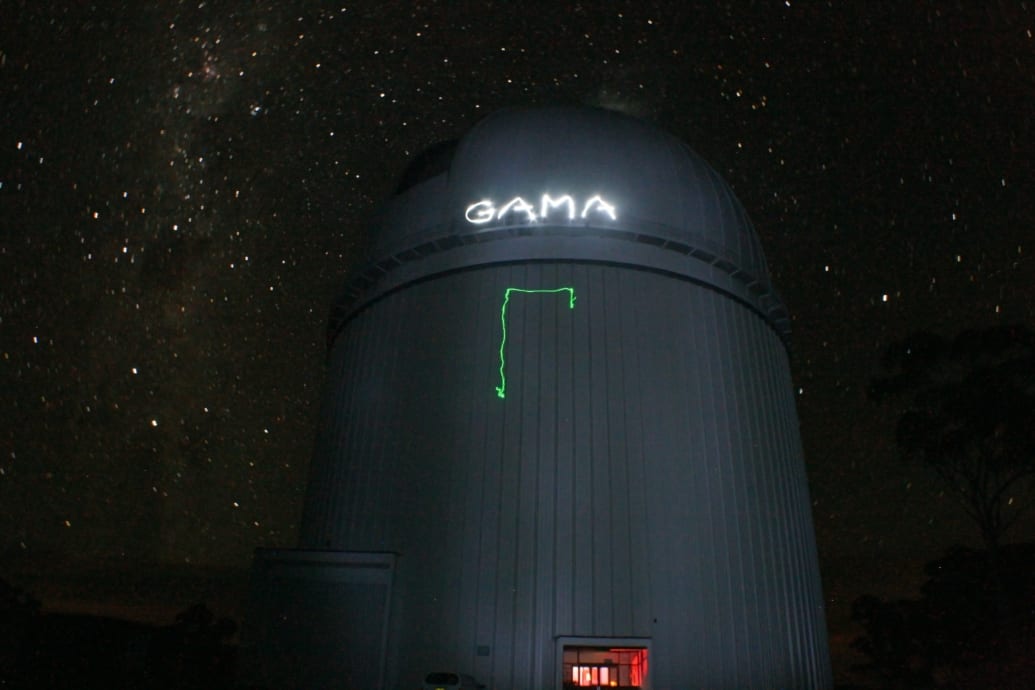To understand that the Milky Way galaxy isn’t a uniform structure, all you have to do is look up at the night sky and find the constellation Sagittarius. From our point of view here on Earth, the stars are thickest in the middle bulge of our spiral-shaped galaxy—a bulge that’s visible as a smear of starlight behind Sagittarius. That’s the “milk” in “Milky Way.”
But it’s not just galaxies that have texture like this. The whole universe does, too. There are areas that are thick with galaxies and home to huge concentrations of mass and energy, and there are areas where galaxies are sparse and things seem as desolate as you can get. The latter, so-called “voids,” are special—and could hold clues about the forces that shape, well, everything.
Voids contain just a few galaxies that are relatively pristine, unaffected by neighboring galaxies. “Void galaxies are therefore a natural laboratory for us to observe how isolation affects galaxy development, and possibly one of the best ways to do so,” Lori Porter, a University of Louisville astronomer, told The Daily Beast.
For a new peer-reviewed study, which has been accepted for publication in the Monthly Notices of the Royal Astronomical Society, Porter and her co-authors focused on some of the universe’s loneliest galaxies and asked a simple question: How are they shaped?
The answer could hint at why they’re shaped that way. “Do internal or external processes dominate?” Porter asked. In other words, is a galaxy the way it is because of how it interacted with other galaxies? Or did it evolve of its volition?
Enlisting tens of thousands of amateur astronomers for help, Porter and her coauthors scrutinized nearly 16,000 galaxies, identified 400 void galaxies among them, then compared the void galaxies to galaxies in more crowded galactic neighborhoods—which they called “field galaxies.”
Field and void galaxies have more similarities than differences, Porter and her team stressed in their study. “However, we do see evidence from our conclusions that point to how isolated galaxies may evolve differently from their counterparts,” they wrote. While many galaxies, in both crowded and lonely parts of the universe, have big fat bulges in their middles, void galaxies almost always have prominent bulges.
This finding might seem trivial. It’s not. “The structure of galaxies results from the interplay of two formation paths,” University of Hawaii astronomer Brent Tully, who was not involved in Porter’s study, told The Daily Beast.
One is the slow accumulation of interstellar gas, which tends to produce prominent bulges. The other is the collision of galaxies, which tends to redistribute solid matter from one galaxy to another and create wide, flat disks of stars and planets that make a galaxy’s central bulge relatively less prominent.
These categories are not necessarily mutually exclusive. But broadly speaking, a galaxy’s shape points to either a mostly gassy origin or one mostly defined by collisions. “Evaluating the relative importance of disks versus bulges is garnering evidence about the formation history of a galaxy,” Tully said.
But simply spotting a void galaxy, to say nothing of accurately determining its shape, takes an enormous amount of work. Void galaxies are very, very far away from Earth—the closest is around 17 million light-years away. That makes them extremely dim in our night sky.
The Galaxy Mass and Assembly project.
GAMA
Porter and her team started with a huge dataset from the Galaxy And Mass Assembly project, an aggregation of imagery from six different large telescopes: five on the ground in Australia and Chile and two—one each from NASA and the European Space Agency—in orbit. The GAMA dataset contains snapshots of around 375,000 of the hundreds of billions of galaxies that populate the known universe. Porter’s team focused on 15,710 of them.
That’s a lot of images. Scanning even a fraction of them for void galaxies is more work than Porter and her seven coauthors could handle. They needed help. Lots of it.
So they partnered with Galaxy Zoo, an organization led by Haverford College astrophysicist Karen Masters. Galaxy Zoo connects amateur astronomers with raw imagery and provides them instructions for contributing to major research projects. “Citizen science is absolutely critical for work like this,” Benne Holwerda, another University of Louisville astronomer and one of Porter’s coauthors, told The Daily Beast.
Porter, Holwerda, their coauthors and 24,000 volunteers scrutinized each image for the dim smudges that might conceivably be void galaxies, then tried to assess their overall shape. Their judgements could be imprecise, so it was best to get second opinions on each. “With a single person, expert or not, one can disagree or there are mistakes,” Holwerda said. “With voting from many citizen scientists, one can compare.”
“With a single person, expert or not, one can disagree or there are mistakes. With voting from many citizen scientists, one can compare.”
— Benne Holwerda, University of Louisville
Analyzing the resulting data, Porter and her coauthors concluded that void galaxies are bulgier than field galaxies. They weren’t shocked. “The definite presence of bulges, particularly those that are obvious [or] dominant round ones, makes sense,” they wrote.
A bulge is where a galaxy’s oldest stars are concentrated. When a galaxy runs into, or close to, a neighboring galaxy, it might scrape off some of its neighbor’s matter. But this new material tends to spin off into the galaxy’s disk, where it might form new stars and planets. The more the disk grows, the smaller the original bulge appears in comparison.
But what about galaxies that are all alone in their corners of the universe, with no opportunities for swapping solid matter with neighbors? “As a result of their isolation, the lack of material to accrete would result in the bulge being far more dominant than the disk,” Porter and her co-authors wrote. Lonely void galaxies just keep accumulating gas, and getting relatively bulgier. Something that’s much less likely to happen in the universe’s more crowded regions.
Categorizing void galaxies, and defining just how unusual they are compared to “normal” field galaxies, is just a first step. Void galaxies are just different enough from other galaxies, on average, that their star systems and planets might be different, too. “If we can identify further properties of void galaxies that set them apart from galaxies in denser parts of the universe, some of these properties may also be important in planet formation,” Porter said.
If and when we get a close look at the planets inside a void galaxy, we just might find something really special. But verifying that possibility requires much closer surveys of faraway galaxies. The Wide Area Vista Extragalactic Survey, which will lean heavily on the new Vera Rubin Observatory in Chile, plans to image 1.7 million galaxies over the next several years.
WAVES should allow astronomers to identify more void galaxies. “The void galaxies we [already] found themselves can be studied in more detail, as well,” Holwerda said.
Right now all we can do is locate some of the closer voids galaxies and determine their shape. There’s so much more to learn about these lonely galaxies, once we’ve got the technology to see with greater precision past the dense milky smear of our own galaxy.



